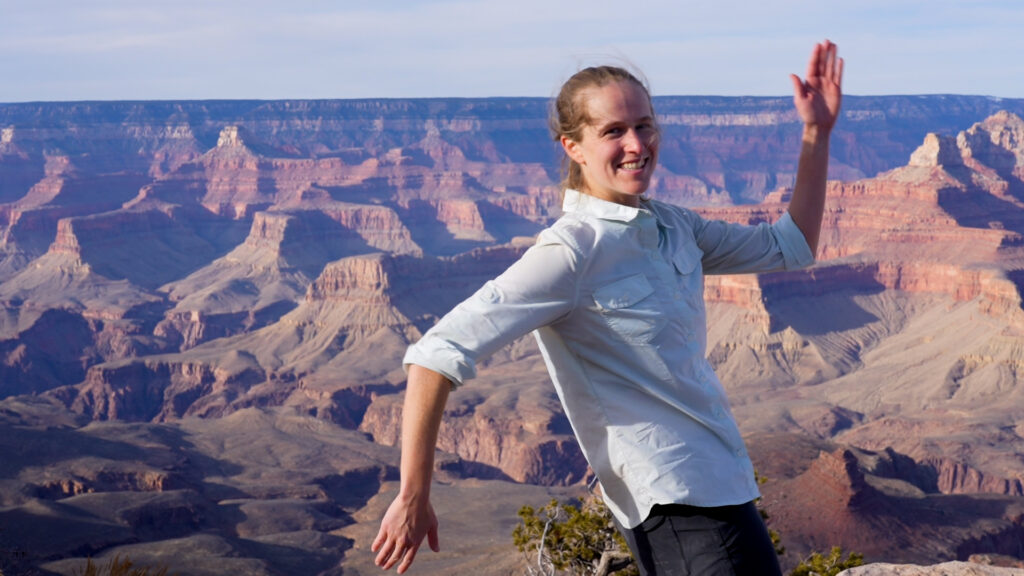Dancing Across the Solar System as the Grand Canyon’s Astronomer in Residence
[ad_1]
When I first imagined choreographing a dance about the connection between the Grand Canyon and how humans explore the solar system, I figured the idea was a little too “out there” to be taken seriously. And yet, last month, I stood at the rim of the Grand Canyon as the park’s official Astronomer in Residence. Perched on a ledge of Kaibab limestone, I began the first gesture phrase that would describe the canyon’s geologic history—and form the backbone for Chasing Canyons, a modern dance solo I premiered at the Grand Canyon’s South Rim on February 23, 2024.
I’m a trained dancer and choreographer, but I’m also a planetary scientist and impact physicist, which means I study the geologic features that get created when an object from space hits a planet. There are other canyons across the solar system, from Mars to Pluto, that are wider, longer, or deeper than the Grand Canyon, but none of them match its sheer power in the human consciousness. Over the month of February, I used my dual backgrounds as a dancer and planetary geologist to choreograph a piece about the emotional and geologic connections between our world and those beyond. My goal? To blend art and science into a singular experience for and about the Grand Canyon.
As someone who actively practices both art and science, I firmly reject the dichotomy we’ve built to separate them. I became a scientist to try to understand my place in the history of the Earth, the solar system, and the universe. I became a dancer and choreographer for those same reasons. The planets are always in motion, and so are we; to me, physically embodying the planets’ orbital dynamics, geologic histories, births, and deaths, is just as valid an approach for connecting with them as gazing through a telescope.
As we think about moving on to the moon and Mars, dancing can help us consider the kinds of futures we’re building. When I dance the canyon, I center my wonder at the scale of what I’ve seen, rather than the ways in which my knowledge of the canyon can be used and commodified. I will always be chasing canyons, but I should never, ever, try to own them.

In making Chasing Canyons, I set out to choreograph a site-specific dance for a site so big it is impossible to see in its entirety. I began with my geologic knowledge of the Grand Canyon, built from my years of scientific training and the weeks I spent climbing up and down its walls. The resulting gesture phrase follows the canyon’s life cycle: the initial crush of its basement rocks, the tilting of overlying strata, the massive gap in time known as the Great Unconformity, subsequent deposition of layers upon layers of sediments, and, finally, the coming of the Colorado River to uncover it all. From there, I began to draw the parts of the canyon that I could see, tracing the terraces and side canyons, dragging feet and fingers from the tops of the cliffs to the shady hollows at the base. I worked in the positions of the stars above the canyon, which mark its location in space and time. Then I merged it all together to create a moving map, not just of the canyon, but of how humans relate to it.
Connecting the canyon to the stars raised more questions: How do we interact with beautiful spaces, here on Earth and elsewhere? When we land on Mars, will we be owners or caretakers? At the end of the piece, I answer these questions: I erase the map. Much like art and science, I think that “to boldly go” and “take only pictures, leave only footprints” are two complementary, not conflicting, philosophies.
My time as the Astronomer (and dancer) in Residence at the canyon has ended, but I will carry it in my body as well as my mind. It is my greatest hope that in making these kinds of dances, I can inspire audiences to expand their minds—to explore the different ways we can understand, learn, and appreciate the universe in which we live.

















